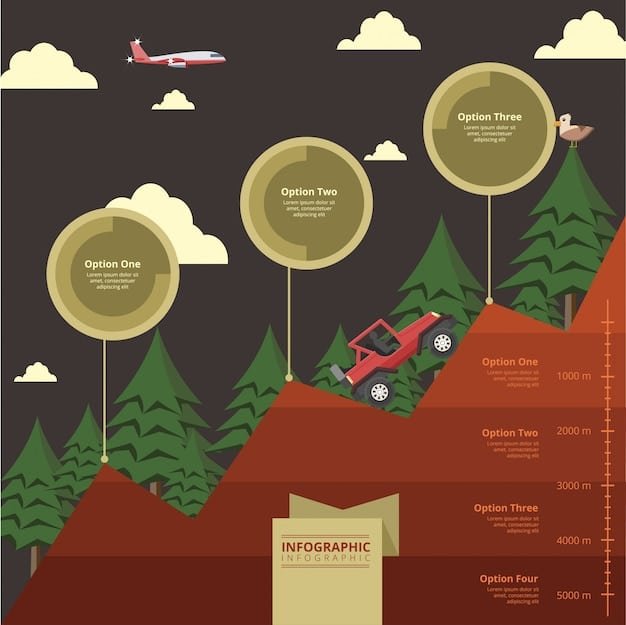Debt Avalanche vs. Debt Snowball: Which Saves More in 2025?

Debt Avalanche vs. Debt Snowball: Which Strategy Saves You More Money in the Long Run? (2025 Analysis) compares two popular debt repayment methods, highlighting that while the debt avalanche method mathematically saves more money, the debt snowball method’s psychological wins can lead to higher success rates for some individuals.
Navigating the world of debt repayment can feel overwhelming. Among the many strategies available, two stand out: the debt avalanche vs. debt snowball: which strategy saves you more money in the long run? (2025 analysis) compares both methods and helps you decide which one can provide the most effective path toward financial freedom in 2025.
Understanding the Debt Avalanche Method
The debt avalanche method focuses on prioritizing debt repayment based on interest rates. It’s about tackling the debt that’s costing you the most first.
How the Debt Avalanche Works
The debt avalanche method is straightforward but requires discipline. You’ll list all your debts, noting the interest rate and the outstanding balance for each.
Then, you’ll make minimum payments on all debts except the one with the highest interest rate. On that debt, you’ll throw every extra dollar you can spare until it’s paid off.
Benefits of the Debt Avalanche
- Cost Savings: By targeting high-interest debt first, you reduce the total interest you pay over time.
- Faster Debt Elimination: Aggressively paying down high-interest debt can accelerate your journey to becoming debt-free.
- Mathematically Superior: When only considering finances, the debt avalanche method is often the most efficient.

The debt avalanche method is effective for those who are motivated by numbers and who can stay focused on the long-term benefits, even if the initial stages don’t provide immediate gratification.
Exploring the Debt Snowball Method
The debt snowball method takes a different approach, focusing on psychological wins. Instead of interest rates, it prioritizes debts with the smallest balances.
How the Debt Snowball Works
Like the debt avalanche, you’ll start by listing your debts. However, instead of focusing on the interest rates, you’ll order them from smallest balance to largest.
You’ll make minimum payments on all debts except the one with the smallest balance. You’ll then put any extra money toward paying off that debt. Once it’s gone, you’ll move on to the next smallest debt, and so on.
Advantages of the Debt Snowball
The debt snowball method generates quick wins and boosts your motivation with each paid-off account.
- Motivational Boost: Paying off small debts quickly provides a psychological boost.
- Behavioral Reinforcement: Small victories reinforce positive financial habits.
- Easier to Stick With: The early successes can make the debt repayment process feel less daunting.
For those who struggle with staying motivated, the debt snowball method can be a powerful tool. The sense of accomplishment derived from eliminating debts, even small ones, can keep you engaged and on track.
Debt Avalanche vs. Debt Snowball: A Detailed Comparison
Choosing between the debt avalanche and the debt snowball requires a thorough comparison of their financial and psychological aspects.
Financial Implications
From a purely financial standpoint, the debt avalanche method tends to save you more money on interest in the long run. By paying off high-interest debts first, you minimize the amount you pay over time.
The debt snowball, however, often results in paying more interest because you’re not prioritizing the most expensive debts initially. The savings are smaller, but potentially more emotionally rewarding.
Psychological Impact
The psychological impact of debt repayment strategies is significant. The debt snowball method can bring a sense of control and progress, motivating you to stay committed.

The debt avalanche method, while financially sound, can sometimes feel slow and discouraging, especially if your highest interest debts have large balances. This can lead to burnout and abandonment of the strategy.
Consider a situation where you owe $5,000 on a credit card with a 20% APR, and $1,000 on a smaller loan with a 5% APR. The avalanche method would target the credit card aggressively, while the snowball would tackle the loan first. The outcome for each could either be cost savings or a psychological boost.
Real-World Examples and Scenarios
Looking at real-world examples can help illustrate the effectiveness of each approach in different situations.
Scenario 1: High-Interest Debt Focus
Imagine Sarah has three debts: a $10,000 credit card at 18% APR, a $5,000 personal loan at 10% APR, and a $2,000 student loan at 6% APR. Using the debt avalanche, Sarah would focus on the credit card first, saving her significantly in interest payments over time.
This approach benefits individuals who can stay disciplined and focused on the financial gains, even if they don’t see immediate progress.
Scenario 2: Small-Balance Debt Focus
Consider Mark, who has a $500 medical bill, a $1,500 balance on a retail credit card, and a $10,000 car loan. The debt snowball method would lead Mark to pay off the medical bill quickly, followed by the retail credit card. This gives him momentum and a sense of accomplishment.
- Quick Wins: Eliminating small debts provides immediate positive reinforcement.
- Increased Motivation: Each paid-off debt motivates continued effort.
- Behavioral Change: The process encourages ongoing financial awareness.
Mark’s scenario highlights the debt snowball method’s emotional and behavioral benefits, making it a viable option for individuals who prioritize motivation and psychological victories.
Adapting the Strategies for Your Personal Finances
Both the debt avalanche and the debt snowball methods have merit, and the best approach for you depends on your financial situation and your personal preferences.
Assessing Your Financial Situation
Before choosing a debt repayment strategy, evaluate your debts, income, and expenses. Look at the interest rates, balances, and minimum payments for each debt.
Consider whether you have any high-interest debts that should be prioritized. Also, think about your financial goals and how quickly you want to become debt-free.
Combining Strategies for Optimal Results
Some individuals find success by combining elements of both the debt avalanche and the debt snowball methods.
- Hybrid Approach: Prioritize high-interest debts while also tackling small balances.
- Customized Plan: Tailor the strategy to meet your specific needs and preferences.
- Continuous Evaluation: Periodically reassess your progress and adjust as needed.
Combining strategies leads to financial efficiency while also maximizing psychological benefits. Creating a hybrid approach allows you to stay motivated while still making significant financial progress.
Long-Term Financial Planning and Debt Management
Debt repayment is just one aspect of long-term financial planning. Once you’ve developed a strategy for eliminating debt, it’s important to create a broader financial plan.
Creating a Budget and Sticking to It
A budget is an essential tool for managing your finances effectively. It helps you track your income, expenses, and savings, allowing you to make informed decisions about your money.
Use budgeting apps or create a spreadsheet to monitor your spending and identify areas where you can cut back. A budget brings a clear path toward your long-term financial goals.
Building an Emergency Fund
An emergency fund can protect you from unexpected expenses and prevent you from accumulating more debt. Aim to save three to six months’ worth of living expenses in a readily accessible account.
Start small and gradually build your emergency fund over time. An emergency fund becomes a safety net and provides financial security in times of unexpected financial stress.
| Key Aspect | Brief Description |
|---|---|
| 💰 Method Focus | Avalanche prioritizes high-interest debts; Snowball focuses on smallest balances. |
| 📈 Financial Savings | Avalanche mathematically saves more on interest in the long run. |
| 心理 Motivation | Snowball provides quick wins, boosting commitment and psychological satisfaction. |
| 🎯 Best Suited For | Avalanche suits disciplined individuals; Snowball is effective for those needing motivational support. |
Frequently Asked Questions
▼
The debt avalanche targets debts with the highest interest rates first, while the debt snowball targets debts with the smallest balances, regardless of interest rate.
▼
The debt avalanche method typically saves more money in the long run because it prioritizes paying off high-interest debts, minimizing overall interest paid.
▼
Yes, the debt snowball method can be better for motivation because paying off small debts quickly provides a sense of accomplishment and momentum.
▼
Yes, you can combine both methods by prioritizing high-interest debts while also tackling smaller balances to maintain motivation and achieve financial efficiency.
▼
Consider your financial situation, including debt amounts and interest rates, and your personal preferences and motivation style to determine which method aligns best with your goals.
Conclusion
Choosing between the debt avalanche and debt snowball methods boils down to your personal financial situation and psychological preferences. While the debt avalanche offers the allure of saving more money on interest, the debt snowball provides motivational wins that can keep you committed to your debt-free journey. Assess your priorities, consider combining the two strategies, and embark on the path that resonates best with your financial habits and goals.





